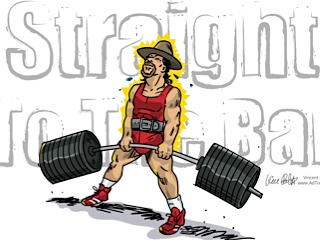One thing we are always interested in regarding functional training is how it carries over into daily life, and other athletic events. A perfect example of this is running. Whenever a new client mentions that he or she runs I give them one piece of advice- “Don’t“.
Interval sprints and the like can be healthy, but the general public labors under the delusion that running is the king of exercises, and since we all know that more must be better, running for hours on end must be great for you, right? You are correct, if your destination is to get to your coffin as quickly as possible, or become a functional cripple by your forties.
If you engage in strength training and have proper running mechanics, you can avoid many of the negative effects associated with long slow distance running. However, most people do not have these things. Therefore they would be better off doing something with no impact on the joints, which combines resistance and cardio. I have just described a kettlebell swing.
To be an efficient runner three of the primary things I need are strong lung capacity, good cardio, and strong legs. Again, I get all of these from kettlebell swings. If you were to engage in a progressive program of kettlebell training (heavy on the swings and snatches) with minimal running performed primarily for specificity you would find that you are a stronger runner than if you had only run.
We know from weight training that the surest way to cease progress is to just keep lifting the weights and always trying to add more on. Yet this is how many (probably most) train for running. Come to think of it, this is how many people also train with weights.
While I was with the California National Guard I had to take part in two of the Army Physical Fitness Tests, each of which required a two-mile run. I ran both tests in about 12:30-13:00 minutes. Not super fast, but I’m a poor runner. I finished ahead of about ninety percent of the battalion, most of whom were a decade younger than myself. I had not run a single mile on my own in about six months. What I had been doing was a boatload of swings. That’s when I stopped running completely.
Something else important to consider is the postural element of running. These same elements apply to biking, to an even greater degree. The big rage in the gyms is the spin class. Now, these do work you hard I agree, but is it worth the negative effects? Next time the spin class ends at your local gym watch everyone who walks out. Most of them will have slumped posture, forward heads, posterior pelvic tilts. Your body will adopt the posture that it perceives to be the norm. If you’re hunched over your desk all day, hunched over the steering wheel in your car while commuting, hunched over a bike in a spin class, or hunched over as you run, why would your body suddenly adopt proper posture? It will adopt the posture that you are most consistently in.
Now we come back to the kettlebell swing. What is my most common admonishment to clients learning the swing?
“At the top of the swing you should be two straight lines. Straight up and down, and straight out to the bell.”
There is no room for slouching in the kettlebell swing. Doing this will only earn you bad form as well as back, shoulder, and elbow pain. Swings performed properly will continue to whack you back into shape, and along with properly performed Turkish Get Ups they will restore your shoulder and front panel flexibility.
I understand that I can’t stop you from running. Well I can, but I don’t have enough duct tape and rope for all of you. So what I instead encourage you to do is swing your kettlebells and minimize the running to what you need in order to remain efficient at it.












0 Comments
Trackbacks/Pingbacks